Setting up a Shopify store in the UAE in 2025 is a great chance for businesses to grow in the fast-growing ecommerce market.
With our experience working with ecommerce websites in the UAE, we’ve seen how Shopify helps brands succeed.
Shopify is a simple platform with all the tools you need to create and manage a professional online store.
Whether you’re starting a new business or expanding an existing one, Shopify makes it easy to design a store that works for your customers.
Its features help businesses build attractive and successful online stores that appeal to UAE shoppers.
In this guide, we’ll share our tips and show you step-by-step how to set up your Shopify store and make it successful in the UAE.
Key Takeaways
Shopify is a popular choice for starting an online store in the UAE due to its ease of use and robust features.
Securing a business license, setting up a local bank account, and registering for VAT are crucial steps before launching your store.
Choosing the right Shopify plan and registering a domain name are essential for establishing your online presence.
Integrating local payment gateways and setting up logistics are key to running a smooth operation.
Customizing your store and marketing effectively can help you reach more customers and boost sales.
Overview of Shopify

Shopify is a powerful and flexible e-commerce platform that simplifies the process of setting up and managing an online store, making it ideal for businesses of all sizes.
In the UAE, we’ve worked with many businesses, helping them tap into Shopify’s potential to succeed in the rapidly growing online market.
Shopify is a popular choice because it combines ease of use with advanced features that can grow with your business.
What makes Shopify stand out is its scalability.
Whether you’re starting with a small online store or expanding into a larger operation, Shopify grows with you.
It offers a wide range of customizable templates and themes, allowing businesses to create a store that truly reflects their brand.
Beyond just product listings and payments, Shopify supports businesses with powerful marketing tools, built-in SEO features, and analytics to track performance.
The platform also integrates with various third-party apps and services, allowing you to add advanced features like customer loyalty programs, email marketing, and more, all without needing technical expertise.
Shopify’s security features are top-notch, offering SSL encryption and PCI-compliant payment systems to ensure both your business and customers are protected.
Plus, Shopify’s mobile app allows you to manage your store from anywhere, making it convenient for busy entrepreneurs.
Whether you’re selling physical goods, digital products, or services, Shopify offers a robust and easy-to-use solution that helps businesses run efficiently while also scaling up as needed.
How to Set Up a Shopify Store in the UAE in 2025?

In this guide, we’ll show you the steps to set up your Shopify store in the UAE, from creating an account to adding local payment gateways.
Based on our experience helping businesses in the UAE, we’ve learned the best ways to make the setup process easy and smooth.
Let’s get started and have your store up and running quickly!
Steps | Action | Description |
1 | Create Your Shopify Account | Sign up on Shopify, choose the UAE, and enter your details for setup. Select a plan after signing up. |
2 | Add Products to Your Store | Add products manually or import them via CSV. Provide product details like title, description, images, pricing, and inventory tracking. |
3 | Choose and Customize a Theme | Go to Online Store > Themes, select a free theme, and adjust the design to match your brand. Optimize for mobile use. |
4 | Add a Custom Domain | Buy a new domain or connect an existing one. Ensure it’s relevant to your business and easy to remember. |
5 | Name Your Store | Go to Settings > General and set a unique, brand-appropriate store name that reflects your identity. |
6 | Set Up Payment Gateways | Choose a payment provider, enter your details, and activate payments. For UAE, use local providers like PayTabs or Telr. |
7 | Configure Shipping Rates | Set shipping rates by creating zones and choosing flat or carrier-calculated rates based on weight or price. |
8 | Test Your Online Store | Place a test order to ensure everything functions correctly (checkout, inventory, shipping, taxes). |
9 | Launch Your Online Store | Finalize your store setup by removing any test restrictions, ensuring the domain is set, and optimizing for search engines. |
Step 1: Create Your Shopify Account
Visit Shopify’s website and select the “Start Free Trial” option to begin.

Select “United Arab Emirates” from the country dropdown to begin setting up your store in the UAE.
Sign up by creating an account with your email or register quickly using Google, Apple, or Facebook ID.
Complete the setup by choosing the plan that aligns with your business needs: Basic, Shopify, or Advanced.
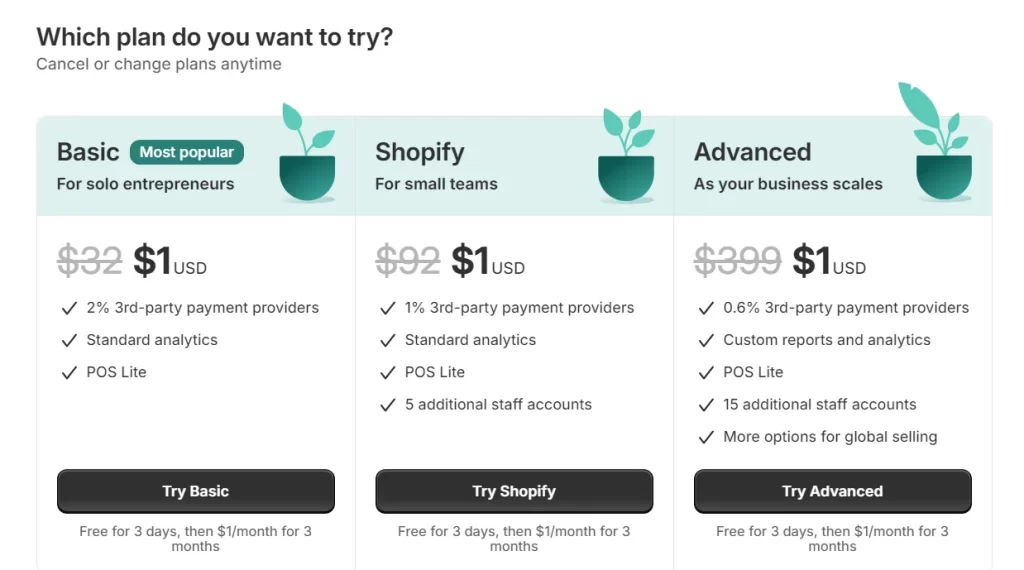
After selecting your plan, provide the necessary information, including your legal business name, address, and billing details, to ensure a smooth and efficient setup process.
Step 2: Add Products to Your Store
To add products, you have two options: manually enter them or import them using a CSV file for greater efficiency.
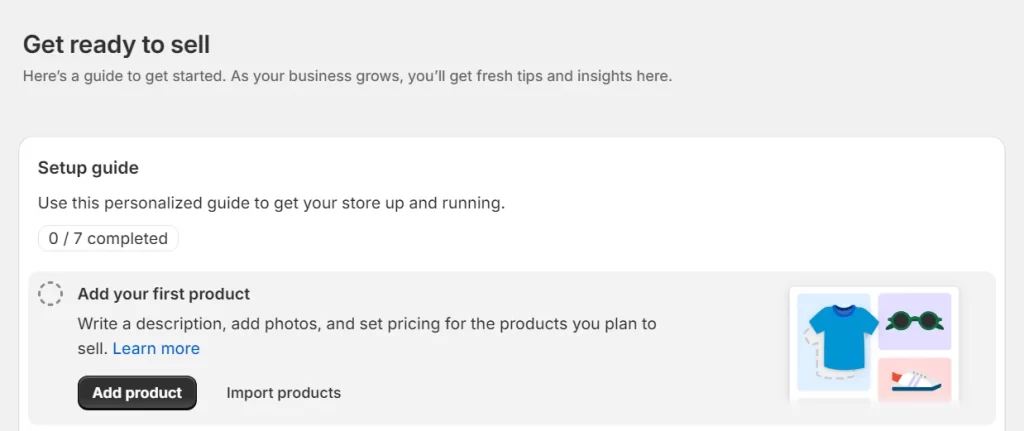
1. Add Products Manually
To manually add products to your Shopify store in the UAE, follow these steps:
From your Shopify admin, go to Products.
Click on Add product
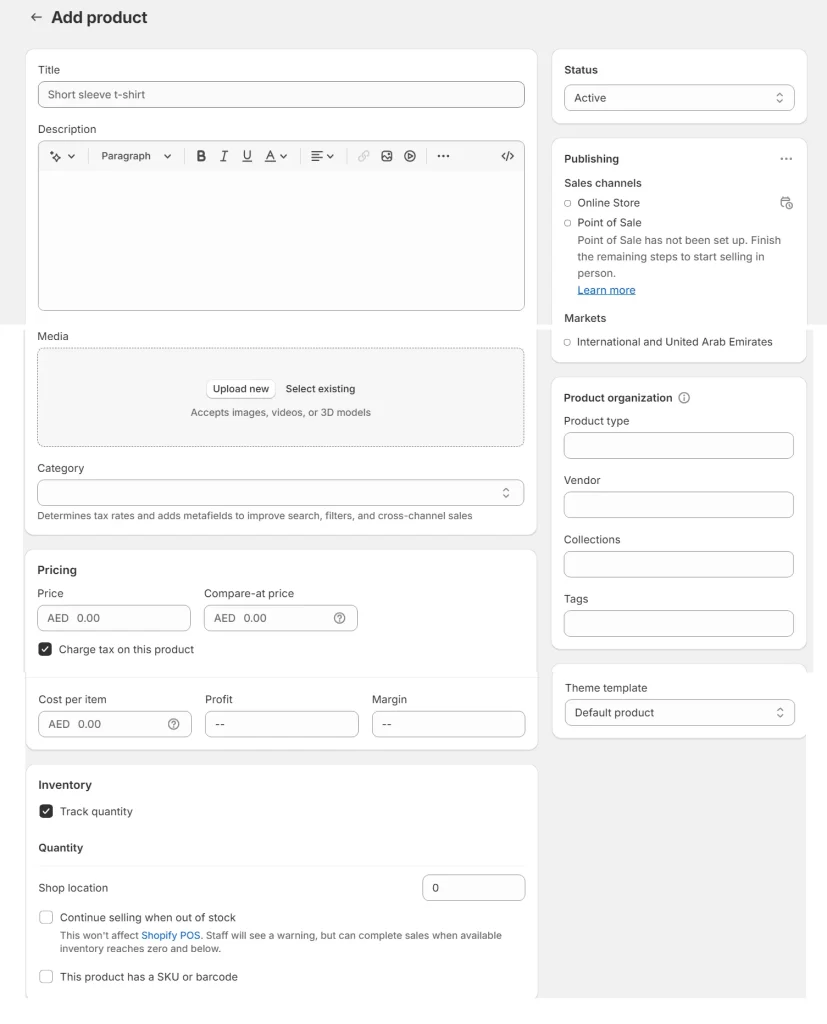
Craft a Clear and Informative Product Title: Ensure the title clearly communicates what the product is and its main function.
Write a Detailed Product Description: Highlight the key features, benefits, and any unique selling points of the product to engage potential customers.
Upload High-Quality Images: Provide clear, high-resolution images for each product, showcasing different angles and key details.
Set Pricing and Tax Information: Price your products in AED and ensure your store’s tax settings comply with the UAE’s VAT regulations.
Enable Inventory Tracking: Keep track of stock levels to prevent overselling. You can still process orders even when the product is out of stock.
Select Sales Channels and Markets: Choose the appropriate sales channels and target markets for your product to reach the right audience.
Include Comprehensive Product Details: Add essential information such as product type, vendor name, and other relevant attributes.
Use Relevant Tags: Implement accurate and strategic tags to increase the visibility of your product in search results.
List the Product: Once all the details are added, set the product status to “Active” to make it available for purchase.
2. Import Products from CSV File
Prepare a CSV file containing all product information, including product title, description, image details, product type, cost, etc.
Click on Import Products.
Click on ‘Add File‘ and select the CSV file you wish to import.
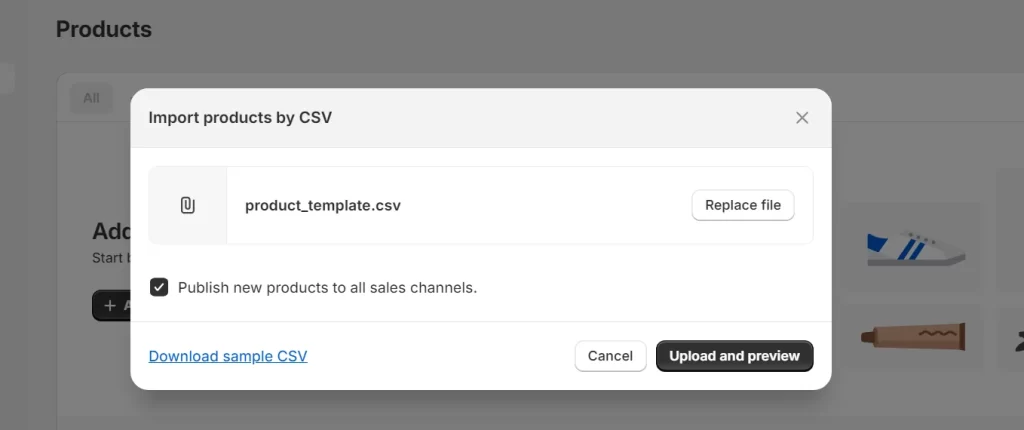
Click on ‘Upload and Preview‘.
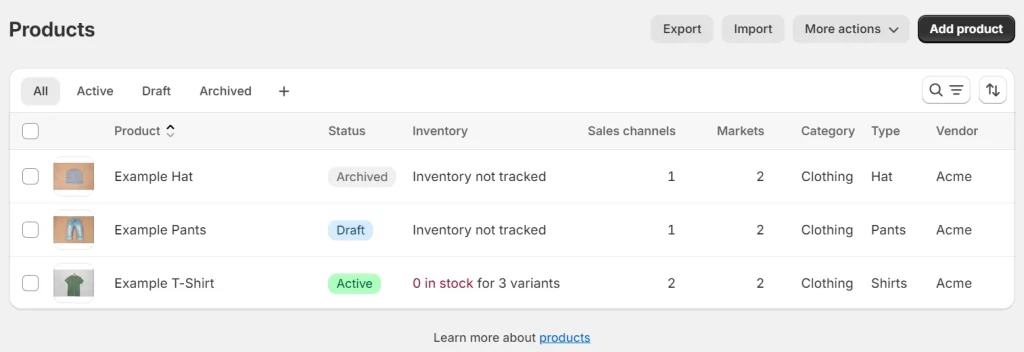
Review the ‘Product Details‘.
Once your CSV file is successfully uploaded, you will receive a confirmation email from Shopify at the email address associated with your store setup.
Please ensure that your product CSV file does not exceed 15 MB in size and follows the required format to prevent any errors during the import process.
Step 3: Choose and Customize a Theme
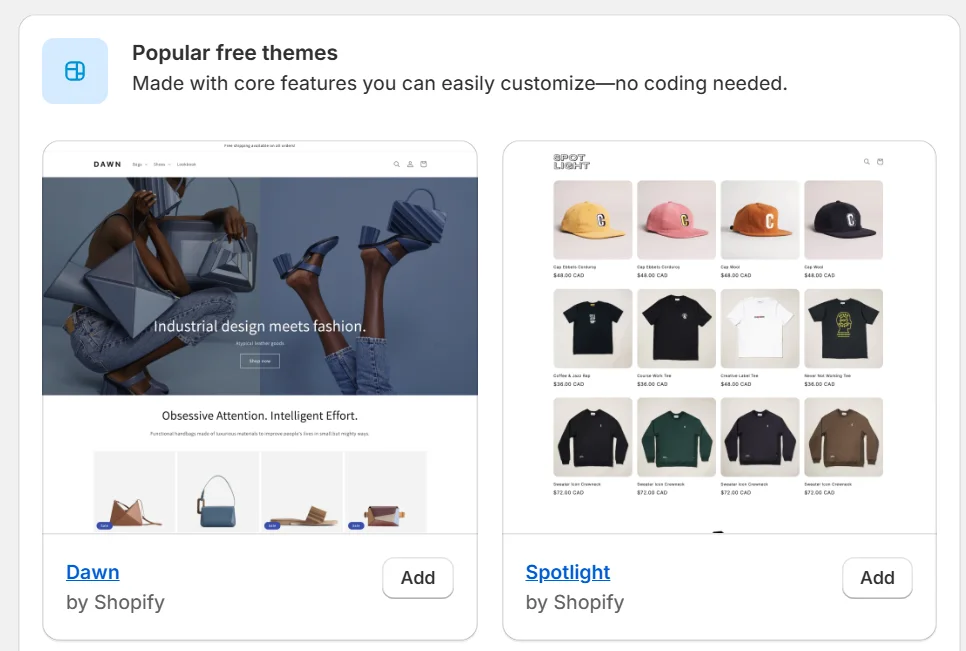
Follow these steps to select and personalize a theme for your Shopify store:
Browse the Theme Store: Navigate to Online Store > Themes in your Shopify admin. Explore free themes directly or visit the Shopify Theme Store for additional options, including premium themes.
Add a Theme to Your Store: Once you’ve found a theme that suits your needs, click Add to incorporate it into your admin. For premium themes, use the Try theme option to preview its features before purchasing.
Customize Your Theme: Click Customize to open the theme editor, where you can adjust your theme’s settings, including colors, fonts, and layout. Add, remove, or rearrange content blocks to align the design with your brand identity.
Preview and Save Changes: Review your updates in real-time using the preview feature. Once satisfied, save your changes to finalize the adjustments.
Advanced Customization (Optional): For more detailed modifications, you can access the theme code by selecting Edit code from the actions menu next to your theme. This option is ideal for users familiar with coding who want advanced control over their store’s design.
Step 4: Add a Custom Domain
If you already have a domain, Shopify allows you to easily connect it to your store.
If not, you can purchase a domain directly through Shopify.

1. Buy New Domain from Shopify
Click on the “Buy New Domain” option.
Search for your preferred domain for your Shopify store in the UAE.
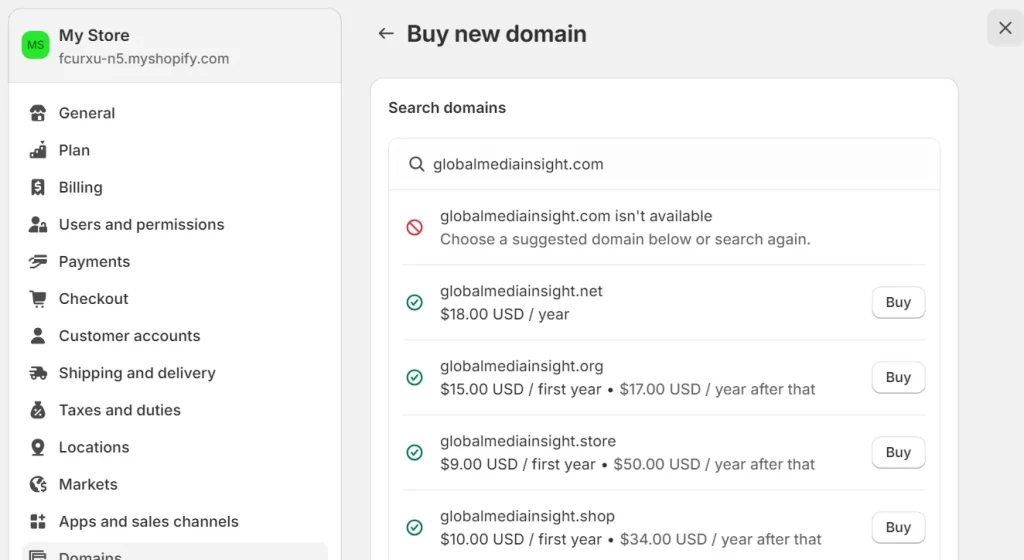
If the domain is available, you may proceed with purchasing it at the specified price.
If the domain is unavailable, you can explore alternative options and purchase other available domains at their respective prices. However, ensure that the domain you choose is relevant to your business and target audience, and is easy to remember.
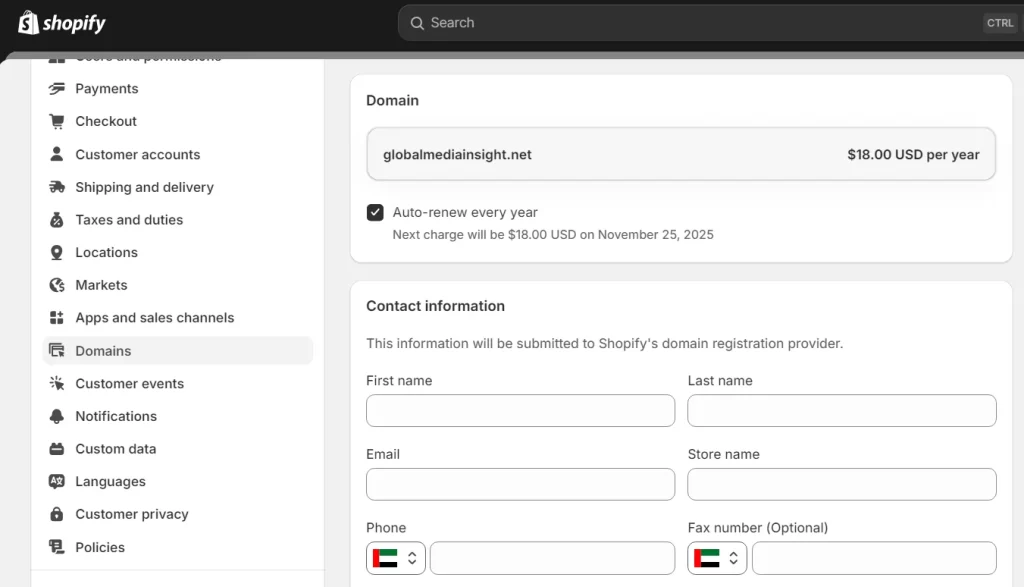
Once you have selected your preferred domain for your Shopify store in the UAE, complete the following steps.
Fill out the contact form with all relevant information, including your email address, phone number, and business address. Ensure that your billing address is accurate to avoid any issues with payments or renewals.
Enable auto-renewal to ensure your domain registration remains active without interruption.
Purchase the domain by completing the payment on the checkout page. Ensure all information is accurate to successfully secure your chosen domain.
2. Connect Existing Domain
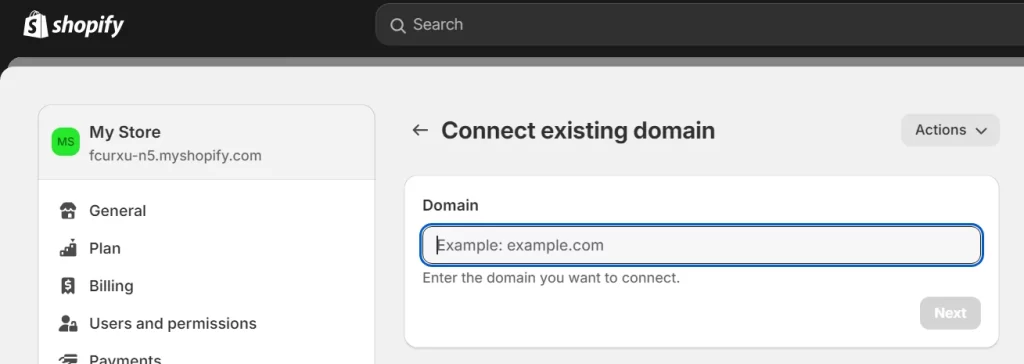
In the ‘Domain’ field, enter the name of the domain you wish to connect your store with.
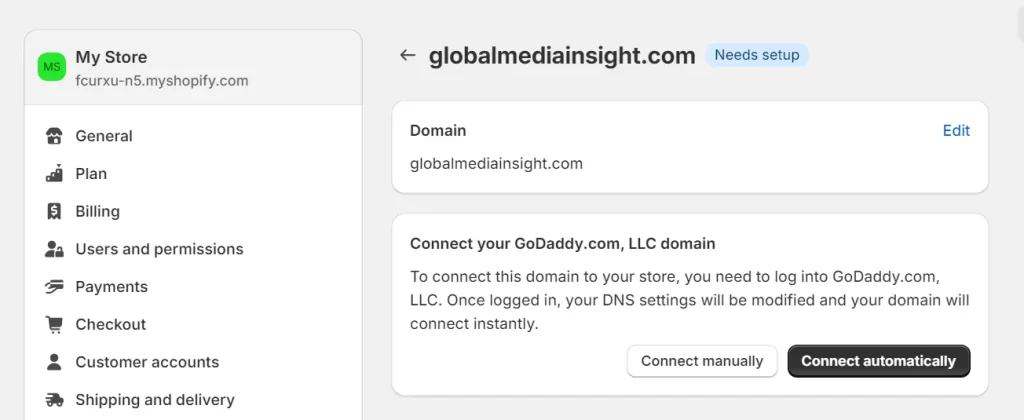
You can connect your existing domain either manually or automatically.
(a). Connect Automatically
To automatically connect your existing domain to Shopify, follow these steps:
From your Shopify admin, navigate to Settings > Domains.
Select Connect existing domain.
Enter your domain name and click Next.
Click Connect automatically. You may be prompted to log in to your domain provider account (e.g., GoDaddy or IONOS) to complete the process.
Once connected, allow up to 48 hours for the domain to be verified and appear as connected in your Shopify admin.
(b). Connect Manually
To manually connect your domain to Shopify, follow these steps:
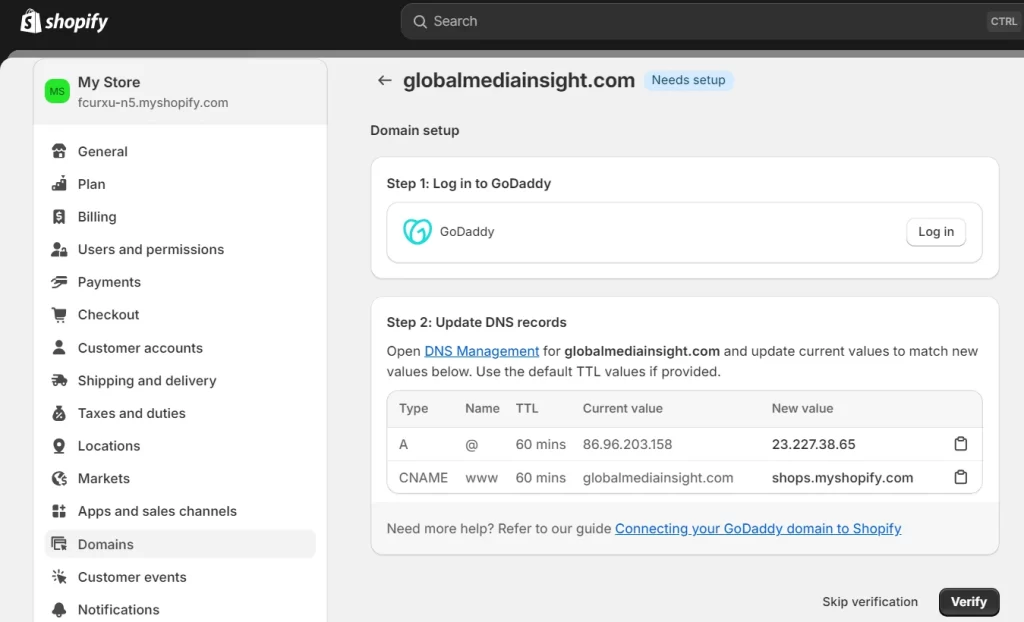
(a). Log in to your domain provider account: Access the DNS settings or domain management section of your third-party domain provider (e.g., GoDaddy).
(b). Update your DNS records:
A Record: Point the A record to Shopify’s IPv4 address: 23.227.38.65. If needed, set the Host name to the @ symbol and remove any existing A records.
CNAME Record: Point the CNAME record with the name “www” to shops.myshopify.com. Ensure that you include a period at the end of the domain.
(c). Click Verify to complete the connection.
Once the changes are made, it may take up to 48 hours for the domain connection to be fully established.
Step 5: Name Your Store
To set your store name in Shopify, follow these steps:
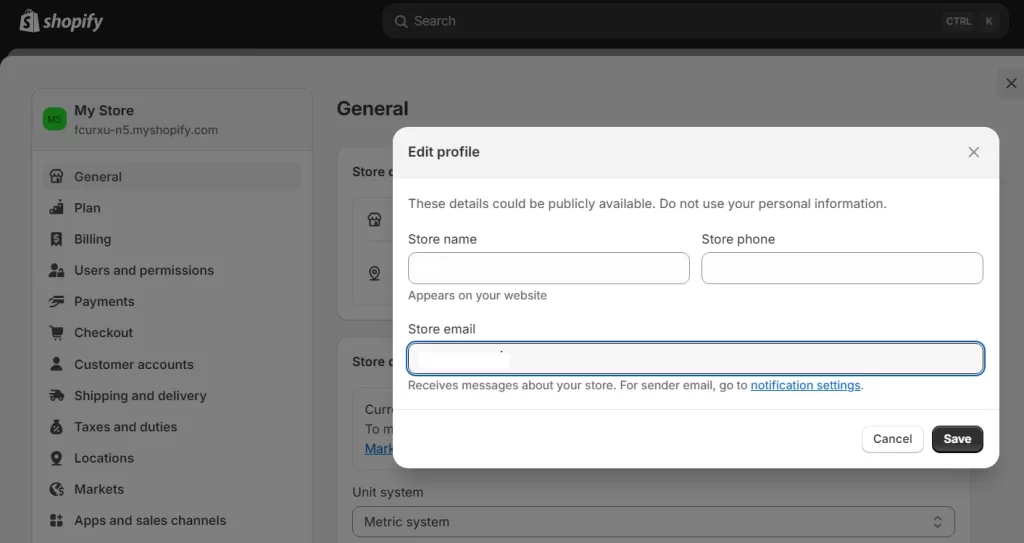
From your Shopify admin, navigate to Settings > General.
In the Store details section, click the pencil icon to edit your store name.
Enter your desired store name, phone number, and email address, then click Save.
Your store name will appear across all pages of your website, so select a name that accurately reflects your brand identity.
Note that you can update your store name at any time.
Step 6: Integrating Payment Solutions
Setting up payment solutions for your Shopify store in the UAE involves a few thoughtful steps.
Choosing the right payment gateway is crucial for smooth transactions.
Here’s how you can integrate payment solutions effectively:
1. Selecting a Payment Gateway
In the UAE, you have several options for payment gateways.
Consider Shopify Payments, Telr, PayTabs, Stripe, or 2Checkout.
Each gateway has its own fee structure and features, so weigh these carefully against your business needs.
For instance, Shopify Payments allows transactions in multiple currencies, which can be beneficial if you plan to sell internationally.
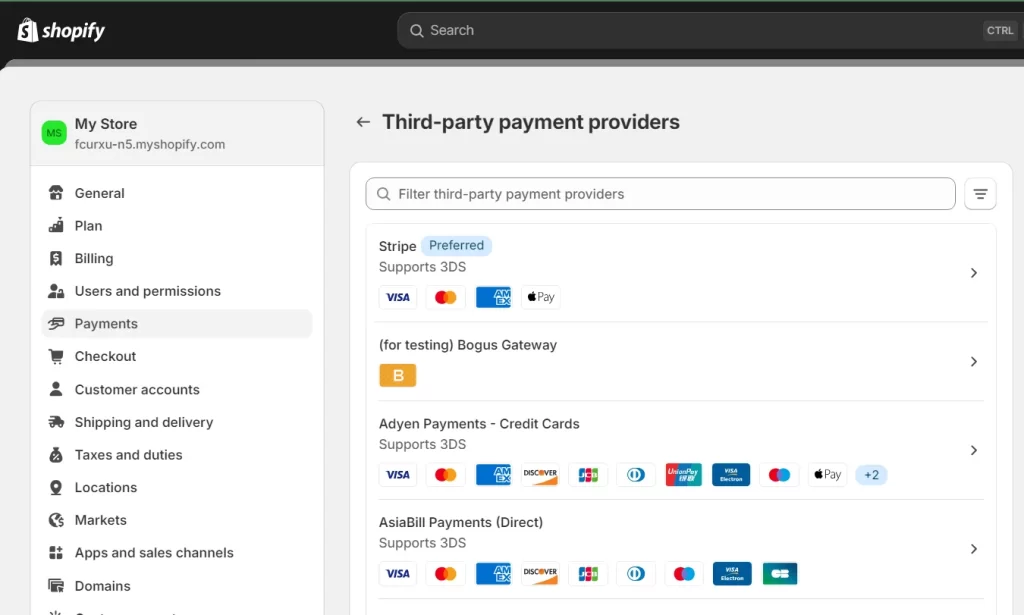
2. Accepting Local Payment Methods
To cater to local customers, it’s important to accept popular payment methods like credit cards, debit cards, and even cash on delivery.
Many UAE shoppers prefer these options, so integrating them can enhance your store’s appeal.
3. Ensuring Secure Transactions
Security is paramount when dealing with online payments.
Shopify provides robust security features, including TLS encryption and fraud prevention tools like fraud analysis.
Regular security updates and two-step authentication add layers of protection, ensuring that both your business and your customers are safe.
Step 7: Shipping and Logistics Management
Efficient shipping and logistics are key to running a successful Shopify store in the UAE.
Let’s explore how to set up and manage these aspects effectively.
1. Partnering with Local Couriers
When you’re setting up your Shopify store in the UAE, it’s crucial to find reliable local courier services.
Partnering with the right courier can make or break your delivery experience.
Look for couriers that offer competitive rates, timely deliveries, and good customer service.
Some popular options include Aramex, Fetchr, and DHL.
You should also consider the courier’s ability to handle returns, as a smooth return process can significantly enhance customer satisfaction.
2. Setting Shipping Rates
Setting appropriate shipping rates is essential for balancing cost and customer satisfaction.
Here’s a simple way to get started:
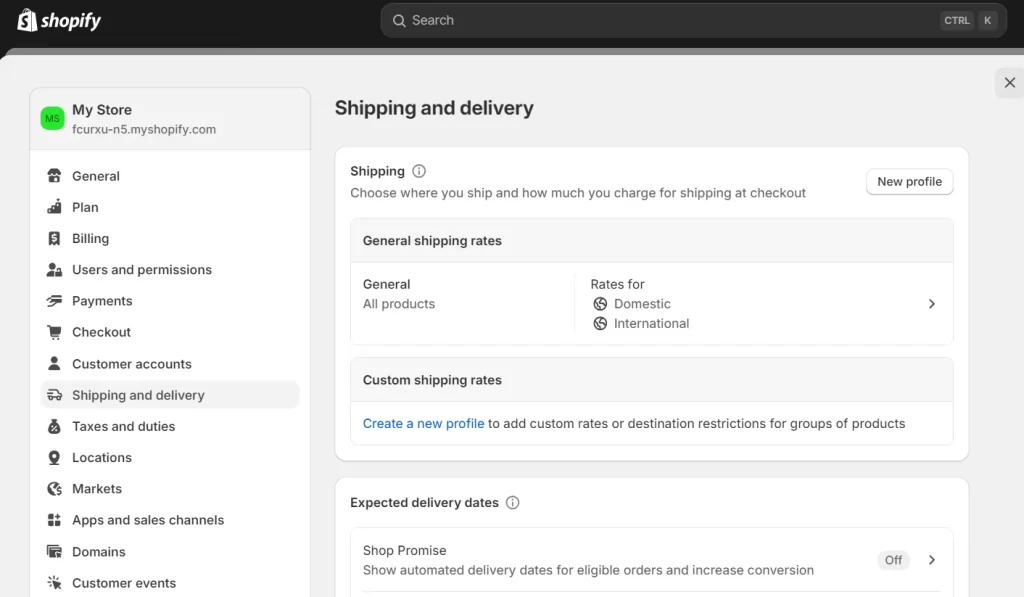
(a). From your Shopify admin, navigate to Settings > Shipping and delivery.
(b). Select the shipping profile you wish to modify.
(c). Under the Shipping zones section, click Add rate next to the zone where you want to apply the rate.
(d). Choose the type of rate you wish to configure:
Flat rate: This is a fixed shipping fee regardless of the order size. It’s straightforward for customers to understand.
Carrier-calculated rate: These rates are calculated based on the courier’s pricing. You can integrate this directly into your Shopify settings.
Free Shipping: Offering free shipping can be a great incentive, especially for orders over a certain amount. However, ensure your pricing strategy covers this cost.
(e). If you wish to set conditions for your rates, you can define either weight-based or price-based conditions.
(f). Click Done, then Save to apply your changes.
Ensure your store’s address is accurate and add any additional locations as necessary to guarantee that your shipping rates reflect your correct location.
3. Handling International Shipping
If you’re planning to expand beyond the UAE, international shipping is something you need to consider.
Choose couriers that specialize in international deliveries and understand the customs regulations of the countries you’re shipping to.
Make sure to factor in duties and taxes during checkout to avoid unpleasant surprises for your customers.
Remember, transparency in costs builds trust and encourages repeat business.
Shipping isn’t just about getting products from point A to B; it’s about creating a seamless experience for your customers. By choosing the right partners and strategies, you can ensure your Shopify store thrives in the competitive UAE market.
Step 8: Test Your Online Store
To ensure everything is functioning correctly, it’s important to place a test order from your own store.
A test order allows you to verify that your checkout process, order processing settings, inventory, shipping, email notifications, and tax settings are all properly configured.
Test orders are not charged to you.
It is recommended to place at least one test order during your store setup or whenever you make changes to your payment settings.
You can place a test order in the following ways:
Use Shopify’s Bogus Gateway to simulate a transaction.
If using Shopify Payments, activate the test mode to test your configuration.
You can also use a real payment provider, then cancel and refund the order immediately. Please note that you may incur fees from the payment processor.
Please remember, testing with a payment gateway is only available if you’ve selected a paid Shopify plan.
Step 9: Launch Your Online Store
To successfully launch your Shopify store in UAE, follow these steps:
Deactivate Test Mode: Navigate to Settings > Payments in your Shopify admin and deactivate the test mode on your Shopify Payments account.
Set Primary Domain: Ensure that your primary domain is correctly set and configured.
Update DNS Records: Verify that your DNS records are properly pointing to Shopify for smooth domain connection.
Submit Sitemap to Google: Submit your sitemap to Google to enhance your store’s SEO.
Remove Storefront Password: Go to Online Store > Preferences in your Shopify admin and disable your storefront password to make your store publicly accessible.
Once your store is live, it is important to test all redirects and fix any 404 errors to ensure optimal SEO performance.
Setting Up a Blog for Your Shopify Store in the UAE
To set up a blog on Shopify for your UAE-based store, follow these steps:
Begin by logging into your Shopify account.
From the admin dashboard, go to Online Store > Blog Posts

Click on Create blog post to start a new blog.

Give your blog a relevant title that aligns with your store’s niche or target audience.
If you’ve created a custom template for your blog, you can optionally choose it from the drop-down menu. This will help maintain a consistent look and feel for your store.
Add the relevant featured image and choose the visible option.
Once all details are filled out, click Save to publish your blog.
This process will help you set up a blog tailored to the needs of your audience in the UAE, providing valuable content and improving your store’s engagement.
Benefits of Using Shopify in the UAE

One of the main benefits of using Shopify in the UAE is its adaptability to local needs.
It supports payments in Dirhams, ensuring a smooth transaction process for customers.
Additionally, Shopify offers integrations with local payment gateways, which is crucial for businesses looking to provide secure and reliable payment options.
Other benefits include:
User-friendly interface that requires no technical skills to operate.
Access to a wide range of customizable themes and templates.
Robust customer support available through various channels.
What Are the Key Requirements for Setting Up a Shopify Store in the UAE?

Launching a Shopify store in the UAE involves adhering to specific legal and business requirements, such as:
1. Obtaining a Trade License
A trade license is compulsory for running an ecommerce store in the UAE.
Depending on your business structure, you can obtain this through the Department of Economic Development (DED) for mainland operations or from a free zone authority for businesses in a free zone.
Choose the license type based on your activities, such as a commercial license for selling products or a professional license for providing services.
2. Setting Up a UAE Bank Account
Having a local bank account is essential for handling transactions effectively.
A UAE-based account enhances payment processing and supports seamless operations with both local and international customers.
3. Registering for VAT
If your annual revenue exceeds AED 375,000, VAT registration with the Federal Tax Authority (FTA) is mandatory.
For businesses earning between AED 187,500 and AED 375,000, voluntary registration can offer benefits, such as increased credibility and tax planning advantages.
4. Business Documentation
Proper documentation is vital for setting up and operating a Shopify store in the UAE.
Required documents may include Passport copies of owners and shareholders.
Memorandum of Association (MOA) if applicable.
Approvals from local authorities, depending on the nature of your business.
By following these steps, you can efficiently set up a Shopify store in the UAE.
However, we recommend consulting local business experts or legal advisors to ensure compliance with regulations and a hassle-free setup.
What Are the Pricing Plans and Subscription Fees for Shopify in the UAE?

Shopify offers a variety of subscription models, with the most notable ones being:
Basic Plan: Ideal for small businesses with simple, local e-commerce needs. This plan includes the essential tools to help you launch and manage your online store effectively.
Shopify Plan: Designed for growing businesses, this plan provides additional features to support expansion, including advanced reporting and more customization options.
Advanced Plan: Best suited for larger, international businesses, this plan offers advanced capabilities such as custom shipping rates, detailed analytics, and the lowest transaction fees, making it ideal for high-volume sellers.
Subscription fees may vary, so it is recommended to visit the Shopify pricing page for the latest information.
Additionally, businesses based in the UAE will be subject to a 5% VAT.
However, businesses with a valid VAT number can bypass these charges by entering their Tax ID in the Shopify admin panel.
A comprehensive understanding of the different Shopify plans enables UAE businesses to select the one that best fits their needs and supports their growth in the e-commerce space.
How Shopify Developers in the UAE Can Help Grow Your Business?
Shopify makes it easy for business owners to create an online store, but long-term success requires a customized approach beyond the basics.
Hiring Shopify developers in the UAE can help you optimize functionality and fully leverage Shopify’s features for sustained growth and stability.
Here’s how Shopify developers in the UAE can assist your business:
Custom Website Designs: Shopify developers can create a unique, branded store with custom themes and features tailored to your business needs. Whether you’re selling multiple product categories or working with various vendors, they can enhance the look and feel of your store while ensuring a user-friendly experience for your customers in the UAE and beyond.
Third-Party Integrations: As your business grows, integrating specialized tools such as CRM systems, payment gateways, inventory management solutions, and marketing platforms becomes essential. Shopify developers can seamlessly integrate third-party APIs to optimize your store’s performance.
Advanced Code Customization: Shopify allows for deep customization. A developer can adjust the code to add custom features, modify layouts, and ensure your store meets your exact specifications, providing a more personalized experience for your customers. This is especially valuable for UAE-based businesses looking to create a unique online presence.
Optimize Performance: A slow website can hurt sales. Shopify developers can improve load times, implement Content Delivery Networks (CDNs), and ensure mobile optimization, offering your customers in the UAE and globally a faster and smoother browsing experience.
Comprehensive Development: Shopify developers offer end-to-end services, from strategy to execution, ensuring your store meets your goals and maximizes conversions. They handle everything from design to ongoing maintenance, providing a full development solution.
Enhanced Customer Experience: Shopify experts can design an intuitive layout, streamline checkout, and integrate personalized features to improve customer engagement and loyalty, enhancing the overall shopping experience.
Continuous Improvements: Shopify developers in the UAE stay updated on changing trends and customer preferences, continuously refining your store to provide a unique edge in the local market and beyond, ensuring your business remains competitive in the evolving e-commerce landscape.
To simplify, a Shopify developer in the UAE is a tech-savvy professional who can transform your store into a seamless, high-performance online shopping experience.
Conclusion
Setting up your Shopify store in the UAE in 2025 is just the start of your exciting journey into ecommerce.
With the right approach and tools, your store can grow into a successful business.
Shopify’s platform, combined with effective ecommerce website development strategies, allows you to create a seamless shopping experience that stands out.
Remember, success takes time and consistent effort, so stay flexible, learn from your customers, and keep improving.
Now’s the perfect time to dive in—start building your store today and watch your e-commerce dream come to life!
Global Media Insight, a leading digital marketing agency in Dubai, offers 360-degree solutions, including expert Shopify development services in Dubai. If you need Shopify development or other web development services, contact us today, and let’s create a website that drives success for your business!
Frequently Asked Questions
1. Is Shopify available in the UAE?
Yes, Shopify is fully operational and available for businesses in the UAE.
2. Is a business license requiered to sell on Shopify in the UAE?
Yes, you must obtain an e-commerce license from the Department of Economic Development (DED) or a relevant free zone authority.
3. Which payment gateways can I use on Shopify in the UAE?
Shopify Payments is currently unavailable in the UAE. However, it is compatible with most third-party gateways, such as PayTabs, Telr, Stripe, and CCAvenue.
4. Can I sell globally with Shopify in the UAE?
Yes, Shopify enables you to reach customers worldwide with multi-currency support and international shipping options.
5. How can I manage shipping for my Shopify store in the UAE?
Shopify integrates with leading shipping providers like DHL, FedEx, and UPS, streamlining the process of managing shipping logistics.
6. Is dropshipping possible with Shopify in the UAE?
Yes, you can operate a dropshipping business in the UAE using Shopify’s integrations with apps such as Oberlo and DSers.
7. Does Shopify offer SEO tools for UAE-based stores?
Yes, Shopify provides built-in SEO tools to optimize your store and improve visibility on search engines.
8. What can I sell on Shopify in the UAE?
You can sell a variety of products on Shopify as long as they comply with UAE regulations and guidelines.
9. Can I manage my store's inventory on Shopify in the UAE?
Yes, Shopify offers a variety of inventory management tools to help you track and organize your products efficiently.
10. Do I need a physical store to operate a Shopify store in the UAE?
No, Shopify is a completely online platform, so a physical store is not required to operate your business in the UAE.

GMI’s Research Team is a panel of knowledgeable experts from various fields such as digital marketing, social media, and web development, all united by a common goal—to educate. We enjoy exploring everything from the latest industry trends and emerging technologies to people and demographics, both in the UAE and beyond. Through our blog posts, we share valuable insights that help businesses and marketers stay informed and prepared for the challenges and opportunities that lie ahead.









